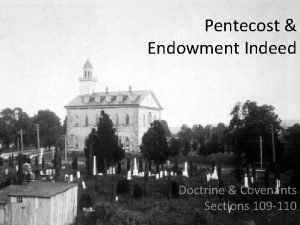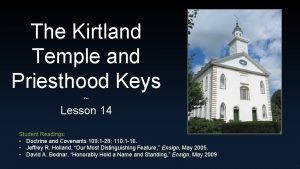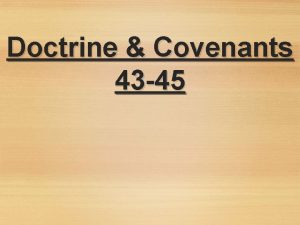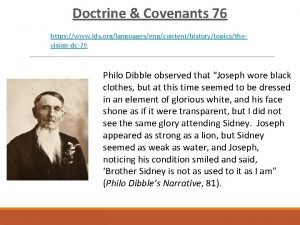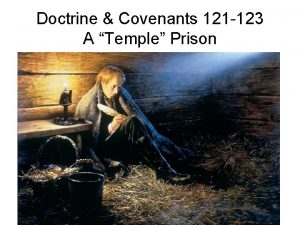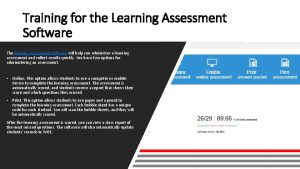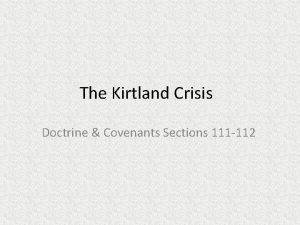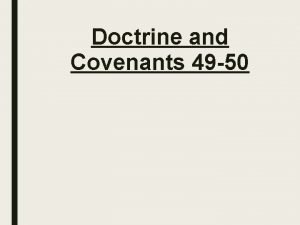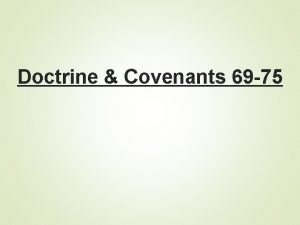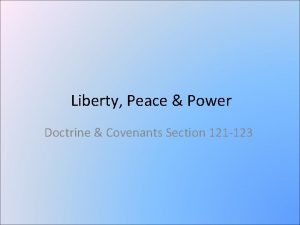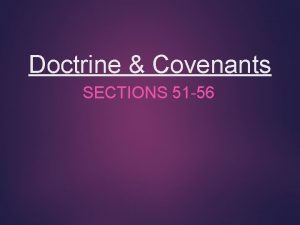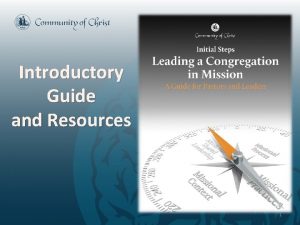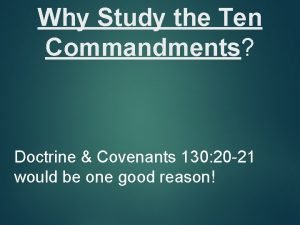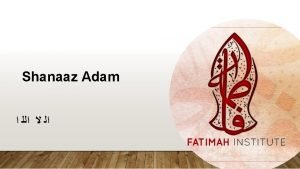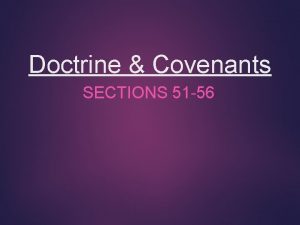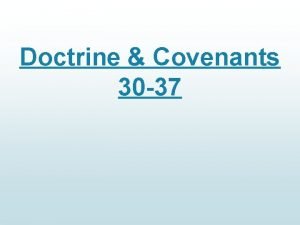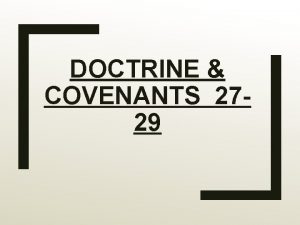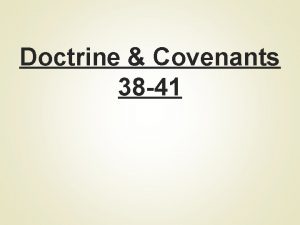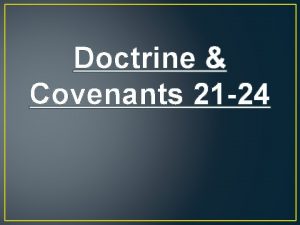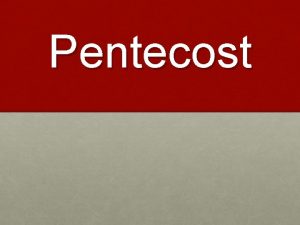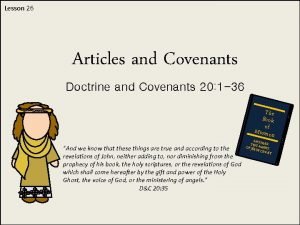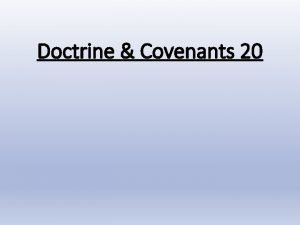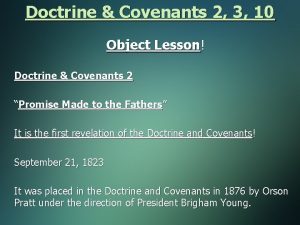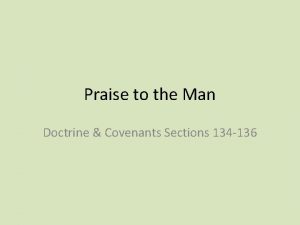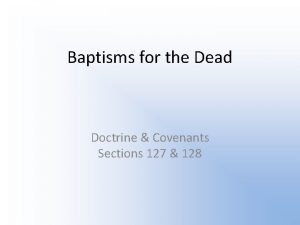Pentecost Endowment Indeed Doctrine Covenants Sections 109 110




















- Slides: 20

Pentecost & Endowment Indeed Doctrine & Covenants Sections 109 -110

Kirtland Temple Timeline • • • 1823 Moroni prophesies endowment of priesthood power (D&C 2) 1831 Endowment promised on condition of unity, consecration, and obedience (D&C 38) 1832 Command to build House of God (D&C 88) 1833 Rebuke for neglecting command, construction begins (D&C 95) 1836 Jan-Mar Preparatory meetings held, quorums instructed, sanctifying ordinances performed (D&C 137) March 27, 1836 Solemn assembly, dedication (D&C 109) Mar 27 -28 Priesthood meeting Mar 29 Washing of leaders’ feet Mar 30 Washing of elders’ feet Mar 31 Dedicatory service repeated April 3 Savior ministers to JS & OC, receives offering, sanctifies, endows with power--Moses, Elias, Elijah confer priesthood keys (D&C 110)

Section 137 Origin • • • Joseph Smith’s older brother Alvin died painfully not long after Moroni appeared to Joseph and taught him of the Book of Mormon plates. Nearly twenty years later Joseph dictated an entry in the Book of the Law of the Lord, the blessing and record book he kept near the end of his life. “I remember well the pangs of sorrow that swelled my youthful bosom and almost burst my tender heart, when he died, ” Joseph said of Alvin. “He was the oldest, and the noblest of my father’s family. He was one of the noblest of the sons of men. ” Even so, at Alvin’s funeral his mother’s minister, Reverend Benjamin Stockton, “intimated very strongly that he had gone to hell, for Alvin was not a Church member. ” Joseph’s father “did not like it. ” He recognized what one philosopher has called the “soteriological problem of evil” (meaning a dilemma between doctrines of salvation), and others have termed a “scandal. ” The problem seems to arise from three truths, any two of which can work together but not all three: 1. God desires the salvation of his children. 2. Salvation comes only through one’s acceptance of Christ’s atonement. 3. Millions of God’s children have lived and died without an opportunity to accept Christ’s atonement. Joseph translated the Book of Mormon, which clarified that unaccountable infants would not be damned, but it said nothing of accountable adults who died before accepting the gospel. He received the priesthood, restored the Church, worked to establish Zion, and built the temple in Kirtland, Ohio. But for all Joseph knew, the Reverend Stockton had been right. Not until the temple was nearly finished did the Lord refute the Reverend’s conclusion. One evening Joseph met on the top floor of the nearly finished House of the Lord in Kirtland, Ohio with the other members of the First Presidency, his father the Church patriarch, Joseph’s secretary, and the bishoprics from Missouri and Ohio. The brethren came to the meeting freshly bathed, symbolizing their efforts to repent and present themselves in the Temple clean before the Lord. The First Presidency consecrated oil, then anointed and blessed Father Smith, who in turn anointed and blessed Joseph. Oliver Cowdery wrote that “the glorious scene is too great to be described. . I only say, that the heavens were opened to many, and great and marvelous things were shown. ” Bishop Edward Partridge affirmed that some of the brethren “saw visions & others were blessed with the outpouring of the Holy Ghost. ”



Section 137 Outcomes • • • Some of the greatest theological minds have wrestled with the soteriological problem of evil. Early Christians philosophers recognized the problem and were sure that Christ would somehow save all the righteous, but already they had lost the significance of truths Peter and Paul taught, leaving no certain answer to the question, “shall those be wholly deprived of the kingdom of heaven who died before Christ’s coming? ” The great Jonathan Edwards longed to find a solution to the problem in the eighteenth century. One faithful contemporary scholar finds in Edwards the seeds of a “dispositional soteriology, ” a doctrine of salvation that only requires one’s disposition to be redeemed by God through Christ. It does not require one to knowingly accept the Savior. But the question persists, “what about those who never heard? ” The revealed answer is not to subtract from the three known truths but to add one more that makes them all compatible and whole rather than problematic to the point of being scandalous. That truth is verses 8 -9 of Section 137. “Thank God for Joseph Smith!” wrote David Paulsen, a philosopher who knows full well the pervasive problem and therefore appreciates the profound solution. His gratitude for Joseph is “not merely for being God’s conduit in resolving one more thorny problem of evil, but for being the instrument through whom God restored the knowledge and priesthood powers that make the redemption of the dead possible. In an eternal perspective, the only evil is damnation, and by solving the problem of salvation for the dead, the Prophet removed the classical barriers encountered in the problem of soteriology. ” Joseph later revealed the ordinance of baptism for the dead that enables all mankind to make and keep the gospel covenants (See Sections 127 -128). Joseph taught the doctrine to his father on his deathbed. In contrast to his reaction to Reverend Stockton’s sermon, Father Smith “was delighted to hear” the truth and asked Joseph to attend to the ordinance. Joseph and Hyrum attended to their father’s dying wish. “I see Alvin, ” Father Smith said just a few minutes before his passing. Prophetically, Section 137 solved a persistent problem faced by Joseph’s family and many, many others.

Section 109 Origin • The Saints put finishing touches on the House of the Lord in Kirtland, Ohio and prepared to assemble in it solemnly as Section 88 commanded them (D&C 88: 70, 117). Joseph spent the day before with his counselors and secretaries “to make arrangements for the solemn assembly. ” Oliver Cowdery’s sketch book adds the detail that he assisted Joseph “in writing a prayer for the dedication of the house. ” The next morning the House of the Lord filled to capacity with nearly a thousand Saints. An overflow meeting convened next door. The solemn assembly began at 9 AM with scripture readings, choir singing, prayer, a sermon, and the sustaining of Joseph Smith as Prophet and Seer. In the afternoon session the sustaining continued, with each quorum and the general body of the Church sustaining, in turn, the leaders of the Church. Another hymn followed, “after which, ” Joseph’s journal says, “I offered to God the following dedication prayer. ” – Dean C. Jessee, editor, Papers of Joseph Smith, 2: 191 -95; Oliver Cowdery, Sketch Book, March 26, 1836, Church History Library, Salt Lake City; Steven C. Harper, “‘A Pentecost and Endowment Indeed’: Six Eyewitness Accounts of the Kirtland Temple Experience, ” in John W. Welch, editor, Opening the Heavens: Accounts of Divine Manifestations, 1820 -1844 (Provo, Utah: Brigham Young University Press, 2005), 327 -71


According to his cousin George A. Smith, Joseph read a printed copy of the dedicatory prayer in the solemn assembly

Section 109 Contents • How did Joseph pray? • What did Joseph pray for?



• Section 109 Outcomes Section 109 dedicated the first House of the Lord in the last dispensation and set the pattern for all subsequent solemn assemblies met for the same holy purpose. It teaches the Saints how to pray, including what to pray for and to ask according to the will of God. It teaches the doctrine and evokes the imagery of the temple, perhaps most poignantly in the idea that temple worshippers can “grow up” by degrees of glory until they become like their Heavenly Father (cross reference Section 93). This is what it means to be exalted in God’s presence. The temple revelations call this fulness, including fulness of joy. Section 109 continues the expansive work of the temple revelations in Sections 76, 84, 88, 93 and points us forward to the culminating revelation on exaltation, Section 132: 1 -20. Section 109 invites mortals who occupy a polluted telestial planet where they cannot think of more than one thing at a time and generally only in finite terms to receive power that will enable them to journey to the real world where God lives “enthroned with glory, honor, power, majesty, might, dominion, truth, justice, judgment, mercy, and an infinity of fulness, from everlasting to everlasting” (77). – See Hugh Nibley, “A House of Glory, ” (Provo, Utah: Foundation for Ancient Research and Mormon Studies, 1993)

Section 110 Origin • A week after dedicating the House of the Lord in Kirtland, Joseph attended meetings there, including an afternoon sacrament meeting. For Christians it was Easter Sunday while Jews were celebrating the Passover season. Joseph and Oliver Cowdery retreated behind the heavy curtains used to divide the room. They bowed in what Joseph's journal describes as “solemn, but silent prayer to the Most High. After rising from prayer the following vision was opened to both of them. ” – Dean C. Jessee, editor, Papers of Joseph Smith, 2: 209; John P. Pratt, “The Restoration of Priesthood Keys on Easter 1836, Part 2: Symbolism of Passover and of Elijah’s Return, ” Ensign, July 1985, 55

Joseph Smith Journal April 3, 1836 handwriting of scribe Warren Parrish Though Section 110 was not widely publicized when it was received and not published until 1852, it was written in Joseph's journal soon after the visions occurred


Section 110 Outcomes • Section 110 fulfills the Lord's conditional promise to the saints that if they would move to Ohio and build him a holy house, he would endow them with power in it (see Sections 38, 88, 95). It fulfill's Section 88's great and last promise (88: 68) that the sanctified would come into the presence of the Lord. Indeed, Joseph promised the saints that "on conditions of our obedience, " the Savior had promised "a visit from the heavens to honor us with his own presence. " – Joseph Smith, Kirtland, Ohio, to William W. Phelps, Independence, Missouri, 11 January 1833, in Joseph Smith Letterbook 1, pp. 18 -20, Church History Library, Salt Lake City

Section 110 Outcomes • Section 110 fulfills a multi-layered prophecy. Through Malachi, the Lord prophesied, “I will send you Elijah the prophet before the coming of the great and dreadful day of the Lord” (Malachi 4: 5). Moroni reiterated this prophecy to Joseph Smith in 1823 (see D&C Section 2). Elijah fulfilled it nearly thirteen years later as recorded in Section 110. Jews had long awaited Elijah's prophesied return and welcomed him during the Passover Seder. On the very day that some Jews were celebrating the sacred meal with the hope that Elijah would return, he came to the House of the Lord. • Moses’ “appearance in company with Elijah offers another striking parallel between Mormon teachings and Jewish tradition, according to which Moses and Elijah would arrive together at the 'end of time. ’” – Stephen D. Ricks, "The Appearance of Elijah and Moses in The Kirtland Temple and the Jewish Passover, " BYU Studies 23: 4 (1903): 483 -86.

Section 110 Outcomes • Section 110 reenacts the endowment received in the Biblical account of the mount of Transfiguration (Matthew 17: 1 -9). Joseph received priesthood keys from heavenly messengers. He had received all the priesthood when he was ordained by Peter, James, and John years earlier (see D&C 27: 12) But he did not have all the keys he needed to exercise the priesthood until after Section 110. In other words, Joseph had power but not permission to send missionaries globally or to perform temple ordinances until Moses, Elias, and Elijah brought him the keys--the permission to exercise the priesthood in those ways. • Section 110 welds dispensations together. Given on Easter and during the Passover season, the revelation links Israel's Old Testament deliverance with Christ's New Testament resurrection and affirms that Joseph Smith and the temple-building Latter-day Saints are the heirs of God's promises to the Israelite patriarchs. Christ is the Passover lamb who "was slain" and then resurrected and now appears to Joseph in Kirtland, Ohio to approve of the Latter-day work and commission the Prophet to fulfill the work of Moses (the gathering of Israel), Elias (the gospel of Abraham), and Elijah (the sealing of families).

Section 110 Outcomes • Section 110 communicates temple knowledge and power. It came in the temple, behind a veil, was recorded but not preached, and acted on but not publicly explained. After the revelation, Joseph used the keys to gather, endow, and seal in anticipation of the Savior's second coming • Section 110 restores temple-related power and knowledge that Moses possessed and "plainly taught, " but which had been forfeited by the children of Israel (D&C 84: 19 -25). • Joseph put the keys to use against great opposition. Not long after receiving the keys to gather Israel from Moses, Joseph whispered in Heber Kimball's ear a mission call to Great Britain. Joseph had previously sent missionaries on short, local or regional missions. Heber and his companions began the ongoing process of gathering Israel from the ends of the earth. Though oppressed by what seems like a concerted opposition that included financial collapse, widespread apostasy, an executive order driving the saints from Missouri, and then unjust imprisonment in Liberty, Missouri, Joseph began to teach and administer the ordinances of the temple. In sum, the endowment of priesthood keys he received authorized him to begin performing temple ordinances.
 Doctrine and covenants section 110
Doctrine and covenants section 110 Priesthood keys the restoration of priesthood keys
Priesthood keys the restoration of priesthood keys Doctrine and covenants
Doctrine and covenants Wwwlds
Wwwlds D&c 121
D&c 121 Doctrine and covenants 21
Doctrine and covenants 21 Doctrine and covenants learning assessment
Doctrine and covenants learning assessment Doctrine and covenants section 111
Doctrine and covenants section 111 Prodigalism
Prodigalism Doctrine covenants 50
Doctrine covenants 50 Doctrine and covenants 69
Doctrine and covenants 69 Section 121 doctrine covenants
Section 121 doctrine covenants Symonds ryder
Symonds ryder Doctrine and covenants 163
Doctrine and covenants 163 Doctrine and covenants 130
Doctrine and covenants 130 Doctrine and covenants 20
Doctrine and covenants 20 Doctrine and covenants 38
Doctrine and covenants 38 101 102 103 104 105 106 107 108 109 110
101 102 103 104 105 106 107 108 109 110 Vignette mutuelle 110/110
Vignette mutuelle 110/110 000 111 000
000 111 000 Successful indeed are the believers
Successful indeed are the believers
